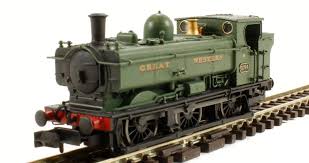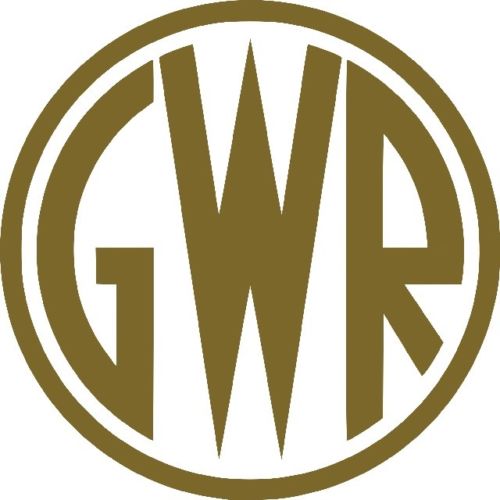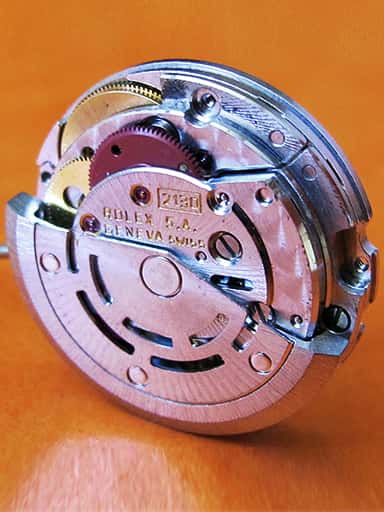DCC Information: Accepts an NEM 651 decoder.
Prototype History: The Great Western Railway (GWR) 5700 Class, or 57xx class, is a class of 0-6-0 pannier tank steam locomotive, built between 1929 and 1950. 863 were built, making them the most prolific class of the GWR, and one of the most numerous classes of British steam locomotive.
Although officially designated by GWR as "light goods and shunting engines", they were also used for passenger working on branch, suburban, and shorter mainline journeys.
They were distributed across most of the GWR network and, after nationalisation of the railways in 1948, across the British Railways Western Region, and also other regions.
The 5700s were not as glamorous as the GWR Castles and Kings, but became just as much of an icon of the GWR.
As a result of the 1955 Modernisation Plan, the 5700 Class was withdrawn from BR service between 1956 and 1966. Nineteen withdrawn locomotives were sold to London Transport and industry, of which ten were later preserved, along with six that were retrieved from scrapyards.
From Wikipedia
From Wikipedia
Road Name History: The Great Western Railway (GWR) was a British railway company that linked London with the south-west and west of England, the Midlands, and most of Wales. It was founded in 1833, received its enabling Act of Parliament on 31 August 1835 and ran its first trains in 1838. It was engineered by Isambard Kingdom Brunel, who chose a broad gauge of 7 ft (2,134 mm)—later slightly widened to 7 ft 1⁄4 in (2,140 mm)—but, from 1854, a series of amalgamations saw it also operate 4 ft 8 1⁄2 in (1,435 mm) standard-gauge trains; the last broad-gauge services were operated in 1892. The GWR was the only company to keep its identity through the Railways Act 1921, which amalgamated it with the remaining independent railways within its territory, and it was finally merged at the end of 1947 when it was nationalised and became the Western Region of British Railways.
The GWR was called by some "God's Wonderful Railway" and by others the "Great Way Round" but it was famed as the "Holiday Line", taking many people to English and Bristol Channel resorts in the West Country as well as the far south-west of England such as Torquay in Devon, Minehead in Somerset, and Newquay and St Ives in Cornwall. The company's locomotives, many of which were built in the company's workshops at Swindon, were painted a Brunswick green colour while, for most of its existence, it used a two-tone "chocolate and cream" livery for its passenger coaches. Goods wagons were painted red but this was later changed to mid-grey.
Great Western trains included long-distance express services such as the Flying Dutchman, the Cornish Riviera Express and the Cheltenham Spa Express. It also operated many suburban and rural services, some operated by steam railmotors or autotrains. The company pioneered the use of larger, more economic goods wagons than were usual in Britain. It operated a network of road motor (bus) routes, was a part of the Railway Air Services, and owned ships, docks and hotels.
From Wikipedia
The GWR was called by some "God's Wonderful Railway" and by others the "Great Way Round" but it was famed as the "Holiday Line", taking many people to English and Bristol Channel resorts in the West Country as well as the far south-west of England such as Torquay in Devon, Minehead in Somerset, and Newquay and St Ives in Cornwall. The company's locomotives, many of which were built in the company's workshops at Swindon, were painted a Brunswick green colour while, for most of its existence, it used a two-tone "chocolate and cream" livery for its passenger coaches. Goods wagons were painted red but this was later changed to mid-grey.
Great Western trains included long-distance express services such as the Flying Dutchman, the Cornish Riviera Express and the Cheltenham Spa Express. It also operated many suburban and rural services, some operated by steam railmotors or autotrains. The company pioneered the use of larger, more economic goods wagons than were usual in Britain. It operated a network of road motor (bus) routes, was a part of the Railway Air Services, and owned ships, docks and hotels.
From Wikipedia
Brand/Importer Information: Dapol Ltd is a Welsh model railway manufacturer based in Chirk, Wales. The factory where design and manufacturing take place is just over the border in England. The company is known for its model railway products in N gauge and OO gauge. Dapol's name is a play on its founders David and Pauline Boyle's names. He owned a model concern Highfield Birds & Models. In 1981 he first tried to buy the Airfix and Mainline ranges. The Dapol brand name was first used in a Railway Modeller advert of September 1983. The first Dapol wagons (for OO) were announced to become available on 20 November 1983. From 1 March 1984 ex Airfix railway kits became available.
Dapol manufactures a growing range of N gauge locomotives, coaches and wagons, and is the main competitor of Graham Farish in the British 'ready-to-run' market. Continuous improvement in model specifications has led to the introduction of 40:1 gearing in locomotive drive mechanisms, NEM couplings on all stock, and LED lighting strips for coaching stock (yellow for 'older' coaches, to represent incandescent illumination, and white for more modern coaches and EMUs to represent fluorescent fittings).
Dapol manufactures a growing range of N gauge locomotives, coaches and wagons, and is the main competitor of Graham Farish in the British 'ready-to-run' market. Continuous improvement in model specifications has led to the introduction of 40:1 gearing in locomotive drive mechanisms, NEM couplings on all stock, and LED lighting strips for coaching stock (yellow for 'older' coaches, to represent incandescent illumination, and white for more modern coaches and EMUs to represent fluorescent fittings).
Item created by: gdm on 2018-09-30 23:34:09. Last edited by CNW400 on 2020-05-24 19:52:14
If you see errors or missing data in this entry, please feel free to log in and edit it. Anyone with a Gmail account can log in instantly.
If you see errors or missing data in this entry, please feel free to log in and edit it. Anyone with a Gmail account can log in instantly.










